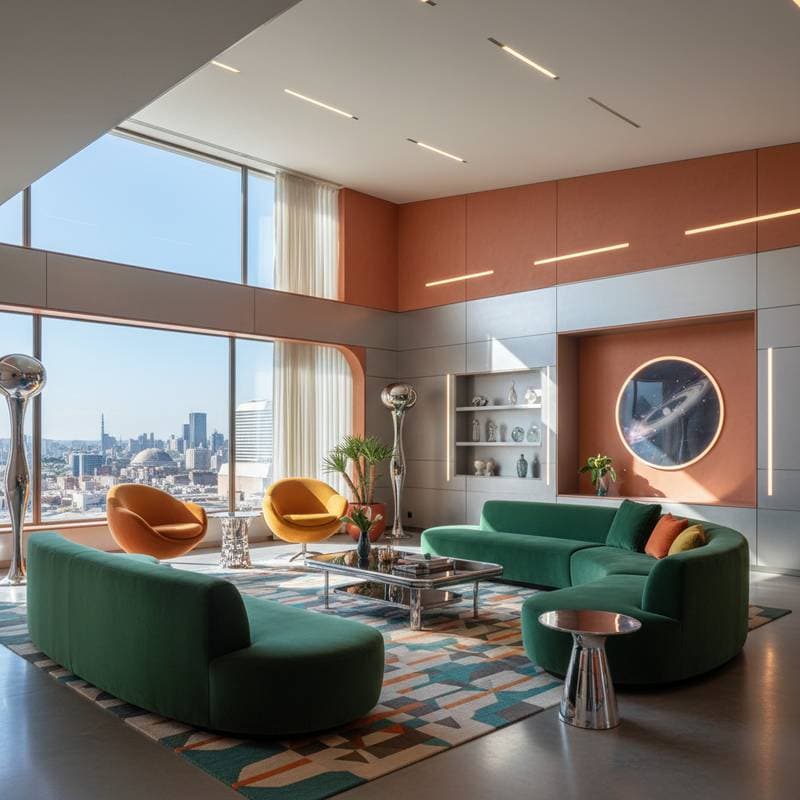1970s Sci-Fi Revival: Retro-Futurism in 2025 Homes
Design influences from classic sci-fi films of the 1970s now shape everyday interiors. Smooth curves, reflective surfaces, and vibrant palettes that once symbolized distant worlds appear in living areas today. This retro-futurist approach merges historical inspiration with current needs, resulting in environments that evoke both familiarity and innovation.
Reasons for the Retro-Futurism Resurgence
The appeal lies in the era's inherent positivity toward progress. Designers from the mid-20th century envisioned streamlined forms and space-age motifs that promised efficiency and adventure. In the present, this aesthetic resonates amid a desire for distinctive yet livable spaces.
Consider how rounded seating or polished tabletops capture that forward-looking essence. The style balances whimsy with purpose, allowing individuals to honor past visions of tomorrow. It serves as a bridge between eras, refreshing homes with a sense of possibility.
Signature Elements of Retro-Futurist Design
Incorporate these core components to achieve the desired effect. Each element draws from 1970s sci-fi while adapting to modern contexts.
-
Curved and Organic Forms
Opt for furniture with flowing lines to introduce softness. Examples include modular sofas with rounded arms or asymmetrical shelving units. These choices enhance visual interest and promote a relaxed atmosphere in any room. -
Reflective Metallic Accents
Select materials like polished chrome or matte aluminum for hardware and fixtures. Apply them to door pulls, table legs, or wall panels. Such details add a subtle gleam that elevates the space without dominating it. -
Vibrant and Confident Hues
Introduce colors such as burnt orange, deep turquoise, or golden yellow through textiles or artwork. Balance these with crisp whites or soft grays to maintain openness. This palette energizes the environment while grounding it in neutrality. -
Innovative Lighting Solutions
Choose fixtures that mimic celestial or geometric patterns. Suspended orbs, linear sconces, or recessed cove lighting provide ambient glow. Position them to highlight architectural features or create focal points in entryways and kitchens. -
Streamlined and Uncluttered Surfaces
Prioritize open layouts with minimal adornments. Display select items like geometric sculptures or modular storage. This approach ensures the design breathes, emphasizing form over excess.
Implementing the Style on a Budget
Achieve this aesthetic through gradual updates rather than complete overhauls. Begin with affordable swaps, such as thrifted lamps or DIY paint applications, costing less than two hundred dollars. Source pieces from local markets or digital marketplaces specializing in vintage reproductions.
For larger transformations, allocate funds toward bespoke elements like custom cabinetry or integrated smart lighting systems. Plan changes in phases: refresh one area per season to manage effort. Most alterations require only basic tools and a weekend's dedication.
Advantages and Challenges of the Approach
Advantages:
- Delivers a distinctive character that differentiates interiors from standard trends.
- Integrates seamlessly with contemporary or antique furnishings.
- Instills an uplifting ambiance conducive to creativity and relaxation.
Challenges:
- Bulky curved items might constrain movement in compact areas.
- Polished elements demand regular maintenance to preserve shine.
- Genuine period artifacts often carry premium prices and limited availability.
Blending Eras for Livable Spaces
Integrate retro elements thoughtfully to avoid an overly thematic appearance. Combine a vintage-inspired pendant with sleek, upholstered loungers, or position a pod chair amid neutral cabinetry. Focus on functionality: select pieces that support daily routines while nodding to sci-fi heritage.
Test combinations in small zones first, such as a reading nook or hallway. Adjust proportions to suit the room's scale, ensuring harmony between old influences and new utilities. This method yields homes that feel authentic and user-friendly.
Steps to Personalize Your Retro-Futurist Interior
Initiate the process with targeted selections that align with your preferences. Replace standard bulbs with diffused globes to alter mood instantly, or apply a bold hue to a single shelf for immediate impact. Source inspiration from era-specific films to guide choices.
Layer textures, such as woven rugs under metallic bases, to add depth. Solicit feedback from trusted advisors during trials. Through iterative refinements, craft an environment that captures 1970s sci-fi allure tailored to contemporary life, fostering joy in every corner.
